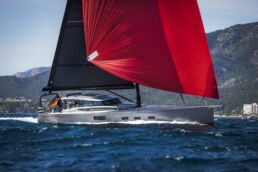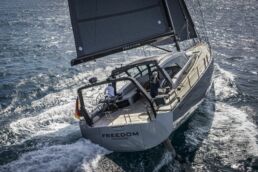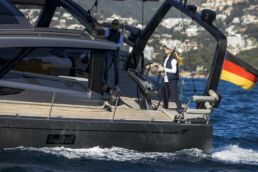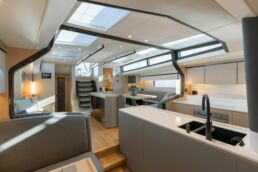The Baltic 67PC is a semi-custom sailing yacht with a fixed hull design and a custom interior.
After its delivery last year and a recent trial sailing in Palma de Mallorca, Baltic 67PC Freedom has rigorously tested its iPhone app and handheld remote-control systems. These tests have demonstrated that these systems are valuable for facilitating easy, fast, and shorthanded sailing.
Freedom is the third Baltic 67PC to be launched and showcases the extent of customization possible in a yacht built from the same hull mold. While all three 67s share identical hull designs by judel/vrolijk, each yacht has a unique interior layout. In the case of Freedom, its distinctive Targa-style protective hardtop, featuring extensive glazing, a large sliding hatch, solar panels, and a safety-focused mainsheet track, has genuinely elevated the deck design of the 67 to a new level.

Baltic 67PC Freedom is made for shorthanded sail cruises.
The owner of Freedom desired a yacht that would allow him to sail effortlessly on his own or with his partner. He carefully selected the yacht’s name to symbolize the enduring Freedom that sailing offers in a world increasingly burdened by limitations.
His primary criteria included exceptional sailing performance and the capability to manage the sail plan and other tasks through advanced press-button electro-hydraulic and remote-control systems. As an example, he can effortlessly maneuver the 3m tender in and out of its stern garage storage solely by utilizing his phone. In a broader sense, he aimed to use his iPhone app to monitor Freedom and enjoy heightened remote surveillance, providing him tranquility.
Lars Gripenberg, the project manager responsible for overseeing the construction of this groundbreaking yacht for Baltic over two years in Jakobstad, has expressed that the system has achieved remarkable success with just a few minor enhancements to the owner’s iPhone application. This innovative system enables the owner to utilize a CZone control system integrated with Sentinel surveillance, granting access to comprehensive electronic monitoring capabilities throughout the entire yacht, including four strategically positioned cameras.
The project manager comments: “With a little fine-tuning the app is working well so that the owner can check on anything from the wind speed and camera surveillance to tank levels and battery state – in a way it’s guardianage by iPhone!”

An iPhone can control the stern garage and passerelle.
As the owner approaches the vessel named Freedom on his electrically-powered tender, he can use his iPhone to open the stern garage, allowing the boarding platform to be deployed upon his arrival. Additionally, he can operate the stern pasarelle, which includes an electric crane designed to lift the tender onto the boarding platform and then slide it into its stern garage storage, all through his phone.
The tender, the 3.00m Zero-Jet produced in New Zealand, showcases remarkable innovation. It utilizes a powerful waterjet propulsion system that is electrically powered. Capable of reaching speeds of at least 25 knots, the boat’s 80kg battery pack provides approximately three hours of use at high speeds and even more when operating at lower speeds.
To control the forceful water flow from the jet, a “bucket” is employed. The designers have ingeniously developed a tiller steering system that overcomes the inherent challenges of some water jet propulsion units, ensuring smoother handling.
The electric tender offers several advantages. It eliminates the need for fuel storage or special ventilation on board the Freedom. When the Zero-Jet is retrieved, it can be connected to the yacht’s extensive electrical system for recharging. Its emission-free nature is an appealing selling point, and the absence of an exposed propeller enhances safety and enables operation in extremely shallow waters.

The handheld radio remote controllers are utilized for various tasks onboard, such as unfurling and furling the in-boom mainsail, controlling the hybrid diesel-electric propulsion system, and deploying and weighing the anchor. A Dockmate joystick is employed for close-quarters maneuvering, utilizing the yacht’s 50kW Molabo electric motor. This eliminates the need to rely on an internal combustion engine while in marinas or alongside.
Freedom’s authentic diesel/electric hybrid powertrain consists of a Volvo D3 150hp main engine and the Molabo unit, which drives a controllable pitch propeller. Lars Gripenberg explained that the diesel engine serves as the primary means of propulsion for the yacht; however, in scenarios where reduced emissions and noise levels are preferred, such as marina work, the electric motor can be selected. When cruising at normal speeds of nearly seven knots, the electric option provides a range of approximately three to four hours, depending on the prevailing conditions. Freedom is equipped with two sets of Mastervolt lithium-ion batteries.

Considering the impressive control systems and hardtop of Freedom, they would be even more astounded by what lies below. The covered cockpit seamlessly leads into the yacht’s stunning and unusually spacious interior. Design Unlimited, the same team responsible for the remarkable hardtop, has made excellent use of the saved space by providing only three sleeping cabins: a large owner’s double suite forward and two cabins aft. In between, the layout is open plan, with the saloon, large galley, and navigation-cum-office merging into one.
The contemporary styling is enhanced by abundant natural light, thanks to deckhead skylights and two large hull-side ports. The result is a spectacularly modern and airy atmosphere.

The amount of space available is quite remarkable. This is partly achieved by positioning the main bulkhead, which separates the main living area from the forward sleeping quarters, further forward than in the previous 67s. Besides being equipped with a lifting keel, Freedom’s telescopic design minimizes any intrusion into the accommodation.
The designers have chosen light oak bulkhead panels, contrasting natural oak sole boards, leather-finished grab handles, contemporary lighting, and clear-coated carbon elements of the yacht’s internal structure to create an incredibly stylish and functional living space.

SHARING IS CARING - THANK YOU!
About Publisher
 Ahoy, I’m René, the “captain” of this luxury yacht blog, and found my passion for the big ones at the age of 17. I have grown up with sailing since a little child. I have an education in Business Informatics and specialized in digital media solutions (alongside luxury yachts) like Online-Marketing, User Experience Design et cetera. My home port is in Oldenburg, Germany next to Lürssen and Abeking & Rasmussen. More about yachtemoceans
Ahoy, I’m René, the “captain” of this luxury yacht blog, and found my passion for the big ones at the age of 17. I have grown up with sailing since a little child. I have an education in Business Informatics and specialized in digital media solutions (alongside luxury yachts) like Online-Marketing, User Experience Design et cetera. My home port is in Oldenburg, Germany next to Lürssen and Abeking & Rasmussen. More about yachtemoceans